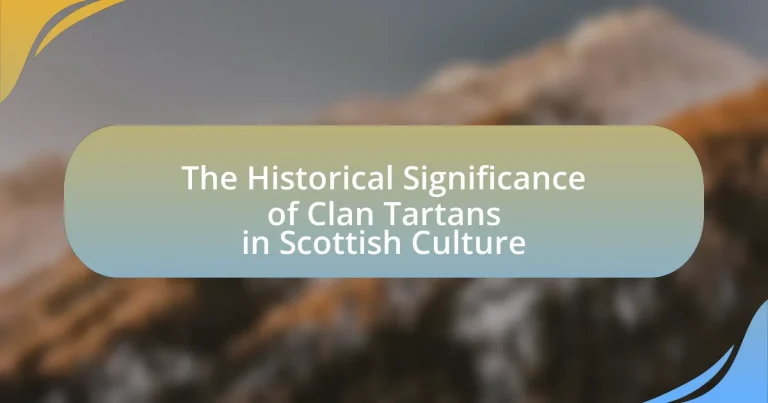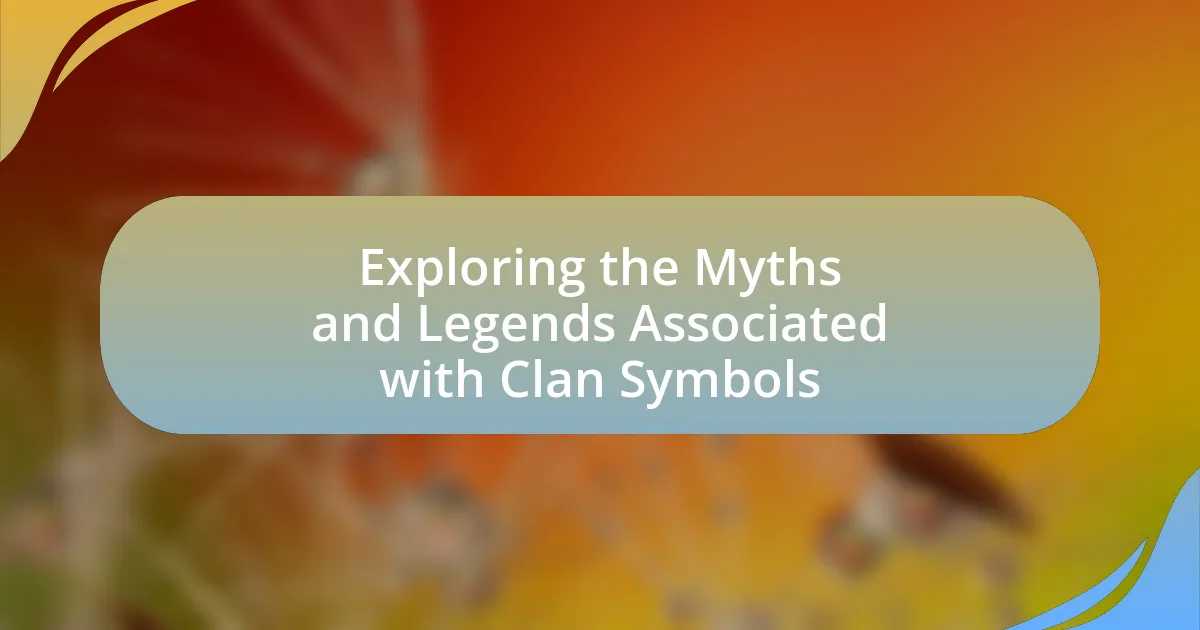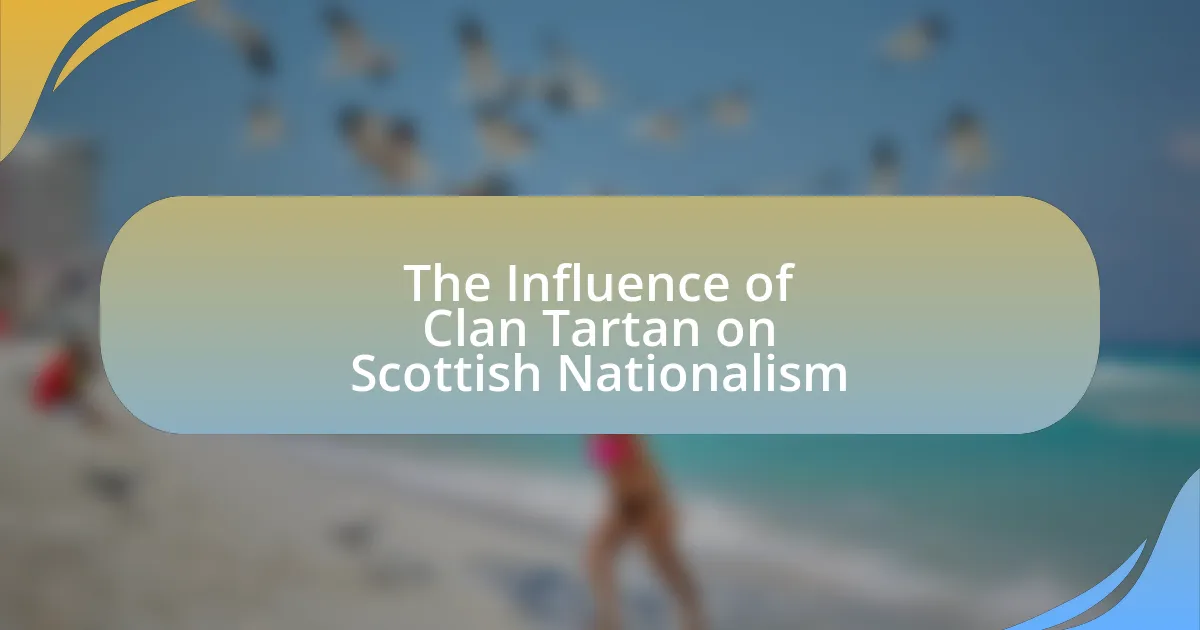Clan tartans are integral to Scottish culture, symbolizing clan identity, heritage, and social status. Each tartan pattern is uniquely linked to a specific clan, serving as a means of identification and expression of lineage, particularly during historical events such as the Jacobite uprisings. The article explores the origins of clan tartans, their historical significance, key figures in their establishment, and their evolution over time. It also examines the role of tartans in modern Scottish culture, their importance in traditional ceremonies, and best practices for individuals to engage with their clan’s tartan today.

What is the Historical Significance of Clan Tartans in Scottish Culture?
Clan tartans hold significant historical importance in Scottish culture as they symbolize clan identity, heritage, and social status. Each tartan pattern is uniquely associated with a specific clan, allowing individuals to express their lineage and allegiance. Historically, tartans were used as a means of identification, especially during the Jacobite uprisings in the 18th century, where wearing a clan’s tartan signified loyalty and unity among its members. The 1746 Dress Act, which banned the wearing of tartan, further solidified its cultural significance as a symbol of resistance and national pride. Today, tartans continue to be celebrated in Scottish culture, representing a rich tapestry of history and tradition.
How did clan tartans originate in Scotland?
Clan tartans originated in Scotland as a means of identifying different clans and families through distinct patterns and colors woven into woolen fabric. The use of tartan can be traced back to the 16th century, where it became associated with specific Scottish clans, each adopting unique designs that represented their heritage and territory. Historical records, such as the 1630s writings of Sir Walter Scott, indicate that tartans were used to signify clan allegiance and social status, solidifying their role in Scottish identity.
What historical events contributed to the development of clan tartans?
The development of clan tartans was significantly influenced by the 16th-century Scottish clan system, which established distinct identities for various clans. This system encouraged clans to adopt unique patterns and colors to represent their lineage and territory. Additionally, the Jacobite uprisings in the 18th century, particularly the 1745 rebellion, played a crucial role in popularizing tartans as symbols of Scottish nationalism. Following the defeat at Culloden, the British government attempted to suppress Scottish culture, leading to a resurgence of tartan as a symbol of resistance and identity among Scots. These historical events solidified the association of specific tartans with particular clans, embedding them deeply into Scottish cultural heritage.
Who were the key figures in the establishment of tartan patterns?
The key figures in the establishment of tartan patterns include Sir Walter Scott, who popularized tartan through his writings in the early 19th century, and the Highland Society of London, which played a significant role in standardizing tartan patterns. Sir Walter Scott’s novel “Waverley” and his promotion of Scottish culture contributed to the romanticized view of tartan, while the Highland Society’s 1815 publication of a tartan registry helped formalize the association of specific patterns with particular clans, thus solidifying their cultural significance in Scottish heritage.
Why are clan tartans important to Scottish identity?
Clan tartans are important to Scottish identity because they symbolize heritage, lineage, and community belonging. Each tartan pattern is associated with a specific clan, representing the history and values of that group. Historically, tartans were used to identify individuals and their affiliations, particularly during the Jacobite uprisings in the 18th century, when they became a symbol of Scottish nationalism. The Scottish Tartan Act of 1815 further solidified the significance of tartans by officially recognizing and cataloging clan patterns, reinforcing their role in cultural identity. Thus, clan tartans serve as a visual representation of Scottish pride and unity, deeply embedded in the nation’s cultural fabric.
How do clan tartans represent familial lineage and heritage?
Clan tartans represent familial lineage and heritage by serving as unique patterns that identify specific Scottish clans. Each tartan design is associated with a particular clan, reflecting its history, values, and social status. For example, the MacLeod tartan features distinctive colors and patterns that signify the MacLeod family’s lineage and connection to their ancestral lands. Historically, these tartans were worn by clan members during significant events, reinforcing a sense of belonging and identity within the clan. The use of tartans has been documented since the 16th century, with the Scottish Tartan Act of 1782 further solidifying their importance in representing clan heritage.
What role do clan tartans play in modern Scottish culture?
Clan tartans serve as a symbol of identity and heritage in modern Scottish culture. They represent familial ties and regional affiliations, allowing individuals to express their connection to specific clans. The use of tartans in contemporary fashion, events, and ceremonies reinforces this cultural significance, as seen in weddings, Highland games, and national celebrations. Additionally, the revival of interest in Scottish heritage since the 20th century has led to an increased popularity of tartans, with many people wearing them to celebrate their ancestry and Scottish pride. This cultural resurgence is evidenced by the establishment of organizations like the Scottish Tartans Authority, which promotes the understanding and preservation of tartan heritage.
What are the different types of clan tartans?
Clan tartans can be categorized into several types, including district tartans, family or clan tartans, and ceremonial tartans. District tartans represent specific geographical areas in Scotland, while family or clan tartans are unique patterns associated with individual clans, often used to signify lineage and heritage. Ceremonial tartans are designed for special occasions and events, reflecting the traditions and customs of Scottish culture. Each type serves a distinct purpose and holds cultural significance, reinforcing the identity and history of Scottish clans.
How are ancient and modern tartans distinguished?
Ancient and modern tartans are distinguished primarily by their patterns, colors, and the context of their use. Ancient tartans typically feature more muted colors derived from natural dyes and simpler patterns, reflecting the local environment and resources available in historical Scotland. In contrast, modern tartans often utilize vibrant synthetic dyes and complex patterns, designed for commercial use and broader appeal, such as fashion and branding. Historical records indicate that ancient tartans were often associated with specific clans and regions, while modern tartans can be created for various purposes, including commemorative or corporate identities, thus lacking the same deep-rooted cultural significance.
What are the specific colors and patterns associated with different clans?
Different clans in Scottish culture are associated with specific colors and patterns in their tartans. For example, the Campbell clan features a dark green and blue pattern, while the MacDonald clan is known for its red and black tartan. The MacLeod clan displays a yellow and black checkered design, and the Stewart clan is recognized for its red and green stripes. Each tartan pattern not only represents the clan’s identity but also reflects historical ties and regional origins, with distinct colors symbolizing various attributes such as loyalty, bravery, and heritage.
How have clan tartans evolved over time?
Clan tartans have evolved significantly over time, transitioning from practical fabrics used for identification and protection to symbols of heritage and fashion. Initially, tartans were handwoven from local wool, featuring natural dyes that reflected the landscape of specific regions, which helped clansmen identify each other in battle. By the 19th century, the romanticization of Scottish culture led to the standardization of tartans, with the establishment of the Highland Society of London in 1778 promoting specific patterns for clans. This period also saw the introduction of synthetic dyes, allowing for brighter colors and more intricate designs. Today, tartans are not only associated with clans but also with various organizations and events, reflecting a broader cultural significance beyond their original purpose.
What influences have shaped the design of tartans throughout history?
The design of tartans throughout history has been shaped by various influences, including geography, clan identity, and social status. Geographic factors determined the availability of natural dyes and materials, leading to distinct color palettes that reflected local flora and fauna. Clan identity played a crucial role, as specific patterns and colors became associated with particular clans, fostering a sense of belonging and heritage. Additionally, social status influenced tartan designs, with wealthier individuals often able to afford more intricate patterns and vibrant colors, while simpler designs were common among the lower classes. Historical events, such as the Jacobite uprisings, also impacted tartan usage and popularity, leading to the formalization of certain patterns as symbols of loyalty and resistance.
How has the perception of tartans changed in contemporary society?
The perception of tartans in contemporary society has evolved from a symbol of Scottish heritage to a global fashion statement. Historically, tartans were closely associated with clan identity and Scottish nationalism, but in recent years, they have been embraced by diverse cultures and fashion industries worldwide. This shift is evidenced by the widespread use of tartan patterns in high fashion, home decor, and accessories, indicating a broader acceptance and appreciation beyond their traditional roots. The rise of social media and global fashion trends has further facilitated this transformation, allowing tartans to be reinterpreted and integrated into various styles, thus enhancing their visibility and appeal across different demographics.
What is the connection between clan tartans and Scottish traditions?
Clan tartans are intricately connected to Scottish traditions as they serve as distinctive patterns representing specific clans, symbolizing identity, heritage, and social status. Each tartan pattern is associated with a particular Scottish clan, often passed down through generations, reflecting the clan’s history and values. Historically, tartans were used to signify allegiance and unity among clan members, especially during the Jacobite uprisings in the 18th century, where wearing a clan tartan was a statement of loyalty. The Scottish Tartan Act of 1782 further solidified this connection by allowing the wearing of tartans, which had been banned, thus reinforcing their cultural significance.
How are tartans used in traditional Scottish ceremonies and events?
Tartans are prominently used in traditional Scottish ceremonies and events as symbols of clan identity and heritage. During significant occasions such as weddings, funerals, and Highland games, individuals often wear tartan patterns that represent their specific clan, reinforcing a sense of belonging and cultural pride. For example, at weddings, the groom may don a kilt made from his family’s tartan, signifying his lineage and connection to Scottish traditions. Additionally, during Highland games, athletes frequently wear tartan to honor their heritage while competing in traditional sports. This practice is rooted in Scotland’s history, where tartans were used to distinguish clans and foster unity among members, making them integral to the cultural fabric of Scottish ceremonies and events.
What significance do tartans hold during national celebrations?
Tartans hold significant cultural and national identity during celebrations, particularly in Scotland, where they symbolize heritage and clan affiliation. The distinct patterns of tartans represent various Scottish clans, allowing individuals to express their lineage and pride during events such as Burns Night and the Highland Games. Historically, the use of tartans was formalized in the 18th century, and they became emblematic of Scottish nationalism, especially during the 19th century when the Romantic movement celebrated Scottish culture. This connection to identity and tradition reinforces the importance of tartans in fostering a sense of community and belonging during national celebrations.
How can individuals engage with clan tartans today?
Individuals can engage with clan tartans today by wearing them in clothing, accessories, and home decor, which reflects their heritage and connection to their clan. Many individuals purchase tartan fabric or garments from specialized retailers, ensuring they select the correct tartan associated with their clan, as each tartan pattern is unique to specific clans. Additionally, participation in cultural events such as Highland games or clan gatherings allows individuals to showcase their tartan and connect with others who share their heritage. The Scottish Register of Tartans, established in 2008, provides an official record of tartans, further facilitating engagement by allowing individuals to verify their clan’s tartan and learn about its history.
What are the best practices for choosing a clan tartan?
The best practices for choosing a clan tartan include understanding the historical significance of the tartan, ensuring it aligns with the specific clan’s heritage, and considering the occasion for which it will be worn. Selecting a tartan that accurately represents the clan’s history is crucial, as each tartan is associated with particular clans and regions in Scotland, reflecting their unique identity. Additionally, it is important to verify the authenticity of the tartan by consulting reputable sources, such as the Scottish Register of Tartans, which documents registered tartans and their associated clans. This ensures that the chosen tartan is not only visually appealing but also culturally and historically accurate.
How can one incorporate clan tartans into personal attire or events?
One can incorporate clan tartans into personal attire or events by wearing garments made from the specific tartan associated with their clan, such as kilts, scarves, or ties. This practice not only showcases personal heritage but also aligns with the historical significance of tartans in representing Scottish clans, as each pattern is unique to a particular family or region. For example, the MacLeod tartan is distinct and symbolizes the MacLeod clan, allowing individuals to express their identity and connection to their ancestry during events like weddings, clan gatherings, or Highland games.





